Beyond opioid and SNRI-like actions: Proteomic insights into the effects of tramadol and O-desmethyltramadol in zebrafish larvae
IF 2.2
2区 生物学
Q4 BIOCHEMISTRY & MOLECULAR BIOLOGY
Comparative Biochemistry and Physiology D-Genomics & Proteomics
Pub Date : 2025-08-18
DOI:10.1016/j.cbd.2025.101615
引用次数: 0
Abstract
The presence of pharmaceuticals in natural habitats is an increasing concern. In particular, the antidepressant tramadol (TRA) and its metabolite o-desmethyltramadol (OTRA) have become ubiquitous compounds in aquatic ecosystems. However, investigation of their impact on fish, particularly on their proteome, still needs attention. Therefore, this work assesses the alterations in the proteome of zebrafish larvae caused by TRA or OTRA exposure.
Zebrafish larvae (0–3 h post-fertilization, hpf) were exposed to 0.1 or 100 μg/L of TRA or OTRA until reaching 168 hpf. The larvae proteome was then investigated through shotgun proteomics, employing the filter-aided sample preparation method (FASP) followed by high-throughput LC-MS/MS analysis. Coupling mass spectrometry quantification with a saturated orthogonal multiple linear regression analysis provided identification of differentially expressed proteins (DEPs). Finally, the functional analysis of these DEPs was performed with STRING-DB online tool to identify possible molecular pathways affected by the treatments.
A total of 162 DEPs were identified, with the highest number observed in larvae exposed to the lower TRA concentration. These highlights possible non-monotonic responses and supports previously described effects for other endpoints, which may affect the serotonergic, noradrenergic and opioid systems. The Kyoto Encyclopedia of Genes and Genomes (KEGG) pathway analysis also indicated putative alterations in metabolic pathways e.g., Glycolysis/Gluconeogenesis, Tricarboxylic Acid Cycle (TCA), Oxidative phosphorylation, Pyruvate metabolism, and Carbon metabolism. Our results suggest that TRA and OTRA exposure may impact vital biological processes in fish larvae, emphasizing the need for adequate integrated monitoring of tramadol, its metabolites, and effects in aquatic ecosystems.

超越阿片类药物和snri样作用:曲马多和o -去甲基曲马多对斑马鱼幼虫影响的蛋白质组学见解
药物在自然栖息地的存在日益引起人们的关注。特别是抗抑郁药曲马多(TRA)及其代谢物o-去甲基曲马多(OTRA)已成为水生生态系统中普遍存在的化合物。然而,研究它们对鱼类的影响,特别是对它们的蛋白质组的影响,仍然需要关注。因此,本研究评估了TRA或OTRA暴露对斑马鱼幼虫蛋白质组的影响。将斑马鱼幼体(受精后0-3 h, hpf)暴露于0.1或100 μg/L的TRA或OTRA,直至达到168 hpf。采用散弹枪蛋白质组学方法,过滤辅助样品制备法(FASP),高通量LC-MS/MS分析幼虫蛋白质组学。耦合质谱定量与饱和正交多元线性回归分析提供鉴定差异表达蛋白(DEPs)。最后,使用STRING-DB在线工具对这些DEPs进行功能分析,以确定受处理影响的可能分子途径。共鉴定出DEPs 162个,以低TRA浓度的幼虫数量最多。这些突出了可能的非单调反应,并支持先前描述的对其他终点的影响,这些终点可能影响血清素能、去甲肾上腺素能和阿片系统。京都基因与基因组百科全书(KEGG)途径分析也表明代谢途径如糖酵解/糖异生、三羧酸循环(TCA)、氧化磷酸化、丙酮酸代谢和碳代谢等可能发生改变。我们的研究结果表明,TRA和OTRA暴露可能会影响鱼类幼虫的重要生物过程,强调需要对曲马多及其代谢物及其对水生生态系统的影响进行充分的综合监测。
本文章由计算机程序翻译,如有差异,请以英文原文为准。
求助全文
约1分钟内获得全文
求助全文
来源期刊
CiteScore
5.10
自引率
3.30%
发文量
69
审稿时长
33 days
期刊介绍:
Comparative Biochemistry & Physiology (CBP) publishes papers in comparative, environmental and evolutionary physiology.
Part D: Genomics and Proteomics (CBPD), focuses on “omics” approaches to physiology, including comparative and functional genomics, metagenomics, transcriptomics, proteomics, metabolomics, and lipidomics. Most studies employ “omics” and/or system biology to test specific hypotheses about molecular and biochemical mechanisms underlying physiological responses to the environment. We encourage papers that address fundamental questions in comparative physiology and biochemistry rather than studies with a focus that is purely technical, methodological or descriptive in nature.

 求助内容:
求助内容: 应助结果提醒方式:
应助结果提醒方式:


